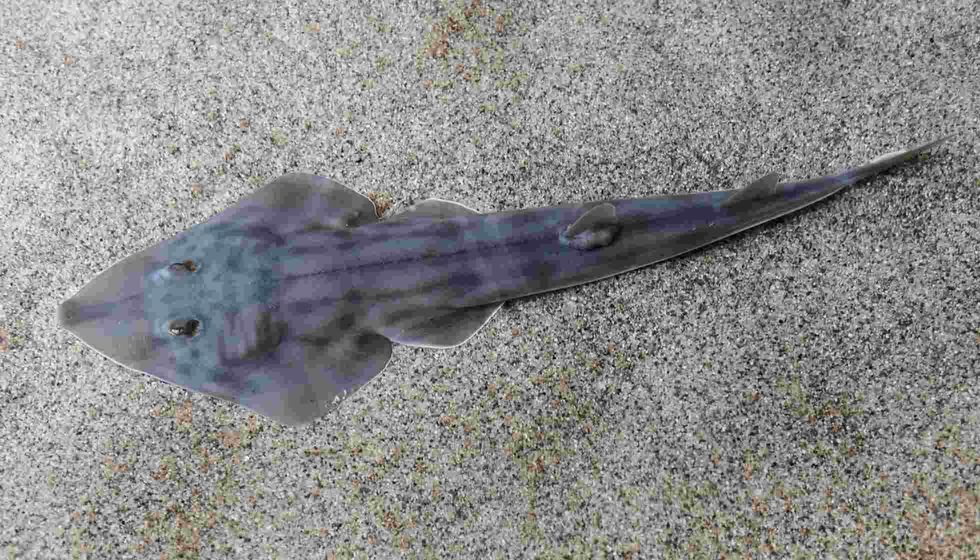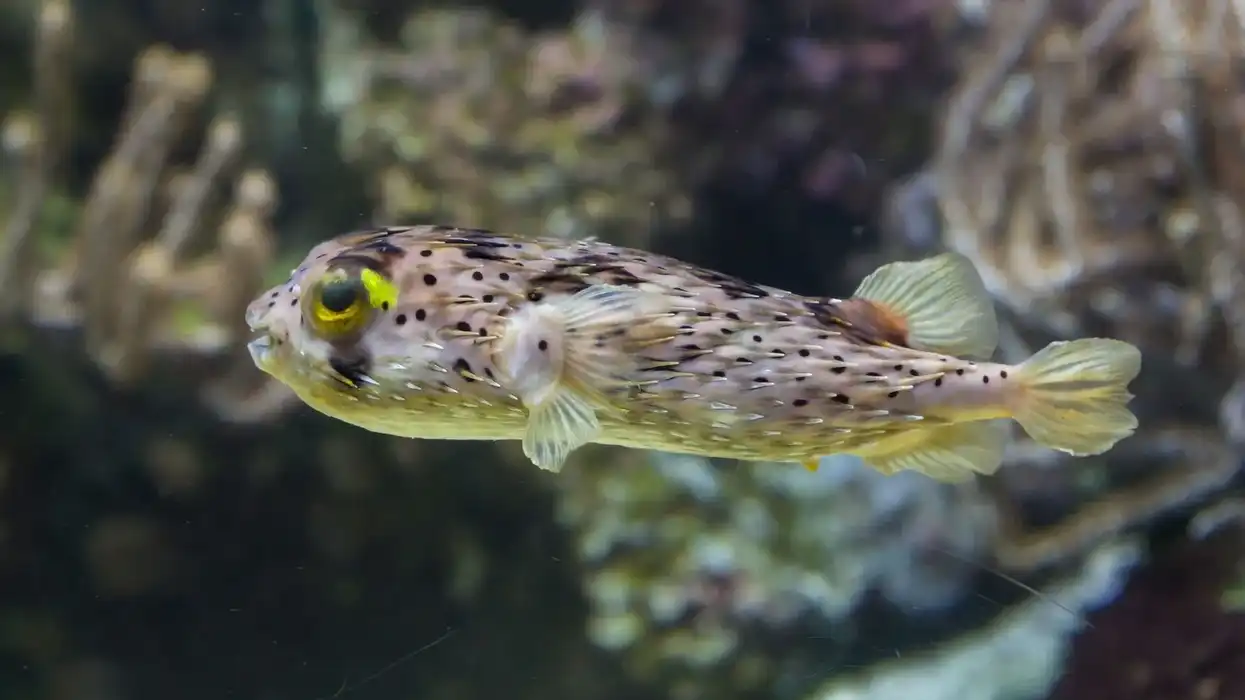Isn't it fascinating that a fish is named after a shovel as well as a guitar?
The name shovelnose guitarfish (Rhinobatos productus) comes from their long, pointed snout, which resembles a shovel, and their guitar-shaped body. The habitat of this fish (family Rhinobatidae) is near soft, sandy beaches, rocky reefs, estuaries, and seagrass beds with an average depth of 42 ft (13 m).
They can be found along the range of the southwestern North American coast, particularly from Guerrero to San Francisco, Mexico, the Gulf of California, and the Baja California.
The males of this marine species arrive in the shallow waters and estuaries of the ocean along the shores of the Baja and southern California sea during the summer season, and the females follow after a while.
The females are ovoviviparous, meaning that fertilization occurs inside the females and then she gives birth to six to 28 well-developed young ones.
These marine creatures search for crabs, worms, shrimp, tiny fish, and clams on the seafloor at night.
Guitarfishes are rays, according to recent research, and are most strongly aligned to the varied group of skates.
Keep reading to know more about these stunning shovelnose sharks. If you like this article, you may also like our other articles on giant guitarfish and bowmouth guitarfish.
Shovelnose Guitarfish Interesting Facts
What type of animal is a shovelnose guitarfish?
The shovelnose guitarfish (Rhinobatos productus) is a type of fish that is a member of the Rhinobatidae family. They resemble a blend between sharks and rays in appearance.
What class of animal does a shovelnose guitarfish belong to?
Shovelnose guitarfish belong to the class of Chondrichthyes. They are also commonly known as the shovelnose shark or sand shark.
How many shovelnose guitarfish are there in the world?
There is presently no information on the number of shovelnose guitarfish present in the world due to a scarcity of population data. However, it is well known that their population is quickly diminishing as a result of Mexican fisheries in northern and central California, as well as shrimp farming along the Pacific coast of northern Mexico.
Where does a shovelnose guitarfish live?
This species can be found around the range of southwestern North America, especially from Guerrero to San Francisco and Mexico, the Gulf of California, and the Baja California.
What is a shovelnose guitarfish's habitat?
The usual habitat of this species is in the range of shallow coastal waters and the surf zone. They cannot go too deep in the ocean and usually remain in the range near soft, sandy shores, rocky reefs, estuaries, and seagrass beds with an average depth of 42 ft (13 m).
Who does a shovelnose guitarfish live with?
This species, also known as the shovelnose shark, is usually a solitary creature. However, during the breeding season, they are seen with their mating partner. They camouflage themselves on the seafloor to avoid being attacked by predators.
How long does a shovelnose guitarfish live?
Shovelnose guitarfish (Rhinobatos productus) are estimated to live in the water for 11 years. However, some have been observed to live up to 16 years.
How do they reproduce?
The mating season of the monogamous shovelnose shark is in the summer season. During this time, the males arrive in the shallow waters and estuaries of the ocean and the females follow after a while.
The females are ovoviviparous, just like most sharks and rays.
This means that fertilization takes place inside the females where the embryos receive all the nutrition from the yolk sac and after nine to 12 months of gestation, they give birth to six to 28 well-developed young ones.
The females return to the mating area which is usually along the coasts of Baja and southern California to give birth from June to October.
The juveniles tend to look after themselves and receive no parental care after taking birth. The sexual maturity of shovelnose guitarfish is usually reached when they are seven to eight years old.
What is their conservation status?
According to the International Union for Conservation of Nature (IUCN) Red List, the shovelnose guitarfish conservation status is Near Threatened.
Their numbers are quickly diminishing since there is no conservation policy to protect them in the United States and Mexico waters due to scarce information about this species. They were previously rejected from commercial catches but are now retained as part of a regular and small fishery in northern and central California.
The shovelnose guitarfish fishery is controlled by NOAA (The National Oceanic and Atmospheric Administration) Fisheries and the Pacific Fishery Management Council (PFMC) through the Pacific Coast Groundfish Fishery Management Plan (FMP).
Shovelnose Guitarfish Fun Facts
What do shovelnose guitarfish look like?
A shovelnose shark has a long, sharp snout that looks like a shovel and a guitar-shaped body, thus justifying the name. The appearance of shovelnose guitarfish is a unique mix of sharks and rays as its tail is thick like a shark while its head looks like that of a ray fish.
These fishes have wide pectoral fins protruding from their sides and two similar-sized dorsal fins near the tail. It has a smooth upper part but its eyes and tail are surrounded by small thorns.
The colors of this species are either sandy brown or olive with white underparts. The color and their compressed body structure help them to stay camouflaged on the muddy seafloor.
How cute are they?
The shovelnose shark is not really cute. Its body has an odd appearance that resembles a shovel.
How do they communicate?
There isn't a lot of information on the communication of this species in marine biology. This species, like other elasmobranchs, have powerful senses for detecting prey. They have a lateral line system that can sense any kind of movement in the water and electroreceptors which help them to search for prey under the sand.
How big is a shovelnose guitarfish?
A female shovelnose guitarfish are comparatively larger than the males. Females are usually 54 in (137 cm) while the males are 47 in (120 cm) in size. They are about three times as big as longhorn cowfish.
How fast can a shovelnose guitarfish swim?
There is not much information on this species' speed. However, it is known that they are slow sea swimmers.
How much does a shovelnose guitarfish weigh?
The shovelnose shark can weigh up to 47 lb (21.3 kg).
What are the male and female names of the species?
Like any other fish species, male and female shovelnose guitarfish do not have any specific names. They are referred to as a male shovelnose guitarfish and a female shovelnose guitarfish. Guitarfishes are referred to as a group of skates.
What would you call a baby shovelnose guitarfish?
A baby shovelnose guitarfish is called a fry.
What do they eat?
At night, this species searches for crabs, worms, shrimp, tiny fish, and clams on the seafloor. The ones living in Elkhorn Slough of California love feeding on yellow shore crabs.
This species waits in ambush, half-buried in the sandy bottom of the sea, for their unsuspecting victims to pass by. As soon as they get close to the fish, they emerge from their hiding place and grab the prey.
Are they aggressive?
Just like the giant guitarfish, this species is not known to pose any threat to humans, unlike some ray or shark species. This is because shovelnose guitarfish do not have any barbs or stingers that can hurt humans.
Would they make a good pet?
No, these small-sized ray fishes are threatened and should not be kept as pets.
Did you know...
The genus name of this fish is Rhinobatis which is a mixture of the Greek word 'rhine', meaning 'shark' and the Latin word 'basis', meaning 'ray'.
The shovelnose guitarfish was mistaken for a shark at first because of its shark-like body and wide dorsal fins.
These fishes are caught by boaters and kayakers in San Diego Bay, San Pedro Bay, and Mission Bay.
Are shovelnose guitarfish edible?
Yes, this fish has a meaty, long, thick, broad-based tail and is delicious to eat. It also does not have any bones, making it very easy to consume.
Why is it called shovelnose guitarfish?
Shovelnose guitarfish have a long, sharp snout that looks like a shovel and a guitar-shaped body. This is why it is given this funny name.
Here at Kidadl, we have carefully created lots of interesting family-friendly animal facts for everyone to discover! For more relatable content, check out these False Catshark facts and Giant Frogfish facts for kids.
You can even occupy yourself at home by coloring in one of our free printable Shovelnose guitarfish coloring pages.









